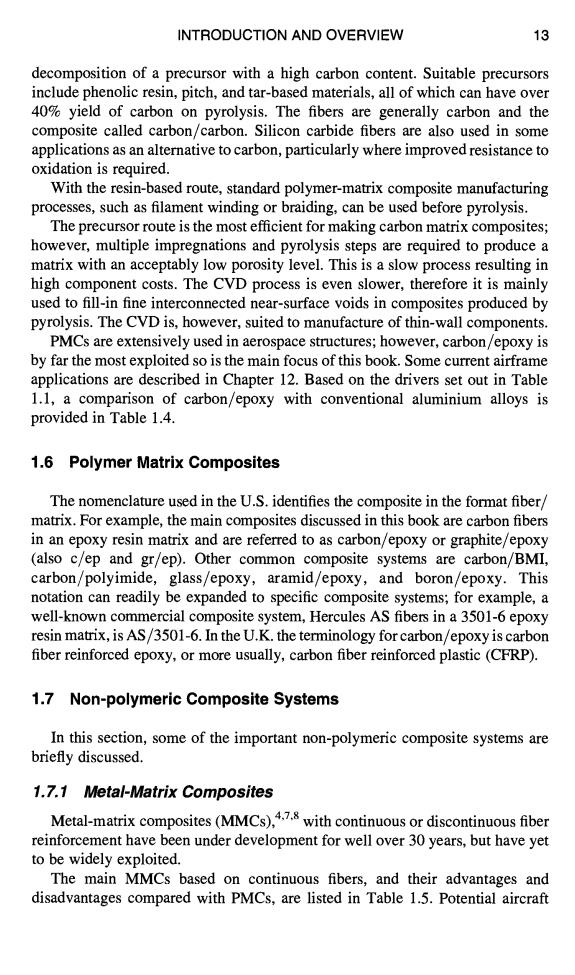正在加载图片...

INTRODUCTION AND OVERVIEW 13 decomposition of a precursor with a high carbon content.Suitable precursors include phenolic resin,pitch,and tar-based materials,all of which can have over 40%yield of carbon on pyrolysis.The fibers are generally carbon and the composite called carbon/carbon.Silicon carbide fibers are also used in some applications as an alternative to carbon,particularly where improved resistance to oxidation is required. With the resin-based route,standard polymer-matrix composite manufacturing processes,such as filament winding or braiding,can be used before pyrolysis. The precursor route is the most efficient for making carbon matrix composites; however,multiple impregnations and pyrolysis steps are required to produce a matrix with an acceptably low porosity level.This is a slow process resulting in high component costs.The CVD process is even slower,therefore it is mainly used to fill-in fine interconnected near-surface voids in composites produced by pyrolysis.The CVD is,however,suited to manufacture of thin-wall components. PMCs are extensively used in aerospace structures;however,carbon/epoxy is by far the most exploited so is the main focus of this book.Some current airframe applications are described in Chapter 12.Based on the drivers set out in Table 1.1,a comparison of carbon/epoxy with conventional aluminium alloys is provided in Table 1.4. 1.6 Polymer Matrix Composites The nomenclature used in the U.S.identifies the composite in the format fiber/ matrix.For example,the main composites discussed in this book are carbon fibers in an epoxy resin matrix and are referred to as carbon/epoxy or graphite/epoxy (also c/ep and gr/ep).Other common composite systems are carbon/BMI, carbon/polyimide,glass/epoxy,aramid/epoxy,and boron/epoxy.This notation can readily be expanded to specific composite systems;for example,a well-known commercial composite system,Hercules AS fibers in a 3501-6 epoxy resin matrix,is AS/3501-6.In the U.K.the terminology for carbon/epoxy is carbon fiber reinforced epoxy,or more usually,carbon fiber reinforced plastic(CFRP). 1.7 Non-polymeric Composite Systems In this section,some of the important non-polymeric composite systems are briefly discussed. 1.7.1 Metal-Matrix Composites Metal-matrix composites(MMCs),4.7.8 with continuous or discontinuous fiber reinforcement have been under development for well over 30 years,but have yet to be widely exploited. The main MMCs based on continuous fibers,and their advantages and disadvantages compared with PMCs,are listed in Table 1.5.Potential aircraftINTRODUCTION AND OVERVIEW 13 decomposition of a precursor with a high carbon content. Suitable precursors include phenolic resin, pitch, and tar-based materials, all of which can have over 40% yield of carbon on pyrolysis. The fibers are generally carbon and the composite called carbon/carbon. Silicon carbide fibers are also used in some applications as an alternative to carbon, particularly where improved resistance to oxidation is required. With the resin-based route, standard polymer-matrix composite manufacturing processes, such as filament winding or braiding, can be used before pyrolysis. The precursor route is the most efficient for making carbon matrix composites; however, multiple impregnations and pyrolysis steps are required to produce a matrix with an acceptably low porosity level. This is a slow process resulting in high component costs. The CVD process is even slower, therefore it is mainly used to fill-in fine interconnected near-surface voids in composites produced by pyrolysis. The CVD is, however, suited to manufacture of thin-wall components. PMCs are extensively used in aerospace structures; however, carbon/epoxy is by far the most exploited so is the main focus of this book. Some current airframe applications are described in Chapter 12. Based on the drivers set out in Table 1.1, a comparison of carbon/epoxy with conventional aluminium alloys is provided in Table 1.4. 1,6 Polymer Matrix Composites The nomenclature used in the U.S. identifies the composite in the format fiber/ matrix. For example, the main composites discussed in this book are carbon fibers in an epoxy resin matrix and are referred to as carbon/epoxy or graphite/epoxy (also c/ep and gr/ep). Other common composite systems are carbon/BMI, carbon/polyimide, glass/epoxy, aramid/epoxy, and boron/epoxy. This notation can readily be expanded to specific composite systems; for example, a well-known commercial composite system, Hercules AS fibers in a 3501-6 epoxy resin matrix, is AS/3501-6. In the U.K. the terminology for carbon/epoxy is carbon fiber reinforced epoxy, or more usually, carbon fiber reinforced plastic (CFRP). 1.7 Non-polymeric Composite Systems In this section, some of the important non-polymeric composite systems are briefly discussed. 1.7.1 Metal-Matrix Composites Metal-matrix composites (MMCs), 4'7'8 with continuous or discontinuous fiber reinforcement have been under development for well over 30 years, but have yet to be widely exploited. The main MMCs based on continuous fibers, and their advantages and disadvantages compared with PMCs, are listed in Table 1.5. Potential aircraft